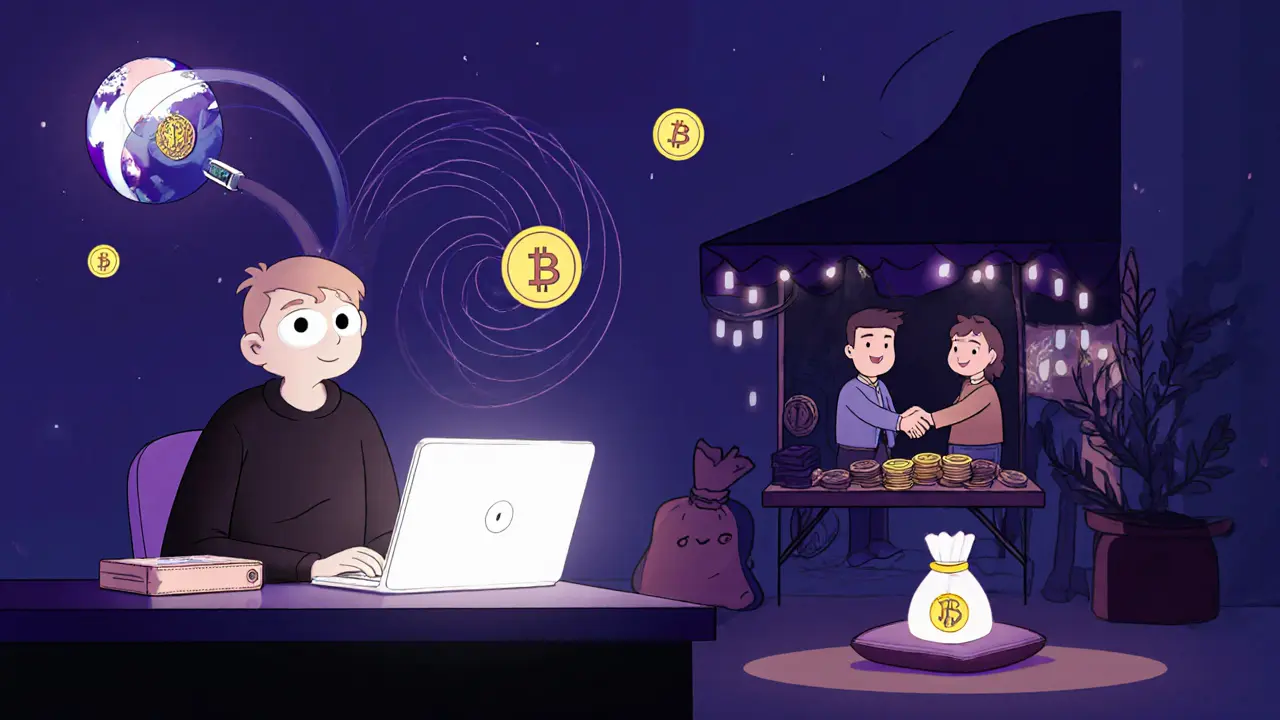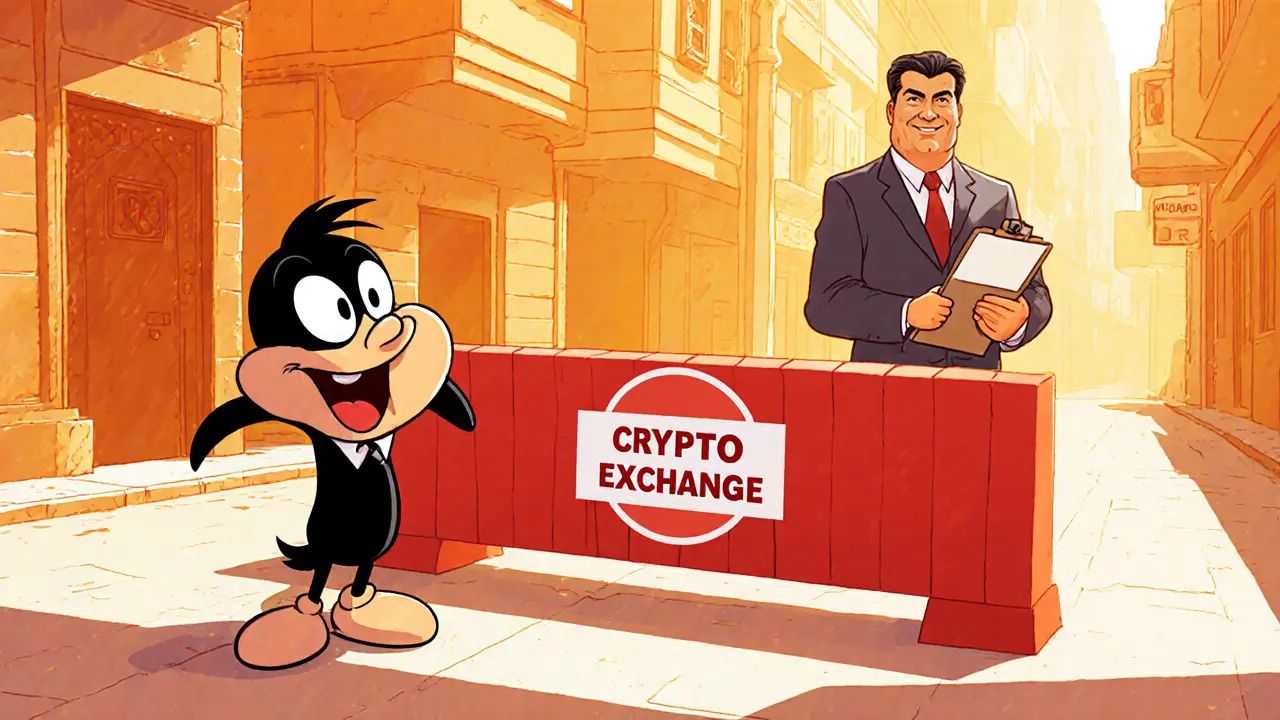Iran Crypto Tax Calculator
Calculate Your Crypto Capital Gains Tax
Under Iran's 2025 regulations, 15% capital gains tax applies to all crypto trades. Calculate your tax liability based on purchase and sale prices.
Cryptocurrency exchange restrictions in Iran have tightened dramatically throughout 2025, turning a once‑relatively open market into a heavily monitored arena. If you’re an Iranian citizen trying to buy, sell, or move digital assets, you’ll want to understand the timeline of government actions, the current practical limits, and the safe‑play options that still exist.
Key Takeaways
- The Central Bank of Iran (CBI) banned rial payment gateways for all crypto exchanges in January 2025.
- After the June Nobitex hack, domestic exchanges cannot trade between 8:00 PM and 10:00 AM local time.
- Capital‑gains tax on crypto trading was introduced in August 2025, requiring license‑holding operators to report profits.
- International freezes-most notably Tether’s July 2025 address freeze-have pushed users toward DAI on the Polygon network.
- Future restrictions are likely to grow, but peer‑to‑peer (P2P) markets and VPN‑based access remain viable workarounds.
Regulatory Timeline in 2025
2025 can be split into four milestone periods that reshape the crypto landscape for Iranians.
- January - Payment‑channel shutdown: The CBI ordered the immediate closure of all rial‑based payment gateways for crypto exchanges. The move was framed as a tax‑evasion crackdown after exchanges processed several billion dollars without transparent accounting.
- June 18 - Nobitex cyberattack: Iran’s largest exchange, Nobitex, suffered a politically motivated breach that erased over $90 million. In response, the CBI imposed a 14‑hour daily trading window (10:00 AM‑8:00 PM).
- July 2 - Tether address freeze: Tether froze 42 wallets linked to Iranian users and to addresses flagged by the Israeli National Bureau for Counter‑Terrorist Financing. The freeze disrupted USDT liquidity and forced a shift toward alternative stablecoins.
- August - Crypto capital‑gains tax: Iran passed the Law on Taxation of Speculation and Profiteering, treating crypto profits like gold or foreign‑exchange gains. Unlicensed traders now face penalties, and licensed exchanges must withhold tax at source.
Major Restrictions Shaping Today’s Market
Below is a snapshot of the most impactful rules that Iranians encounter when dealing with digital assets.
| Restriction | Pre‑2025 | 2025 and Beyond |
|---|---|---|
| Rial payment gateways | Allowed with minimal oversight | Completely blocked by CBI |
| Trading hours | 24/7 operation | Only 10 AM‑8 PM local time |
| Licensing | Voluntary registration | Mandatory CBI license & financial reporting |
| Taxation | No specific crypto tax | Capital‑gains tax applied to all trades |
| Stablecoin access | USDT dominant | USDT wallets frozen; users shift to DAI (Polygon) |
| International sanctions compliance | Limited OFAC enforcement | Active freezes of wallets linked to IRGC‑affiliated networks |

Impact on Everyday Users
For a typical Iranian crypto enthusiast, the new rules translate into three concrete pain points.
- Liquidity crunch. With USDT wallets frozen and Rial gateways shut, converting crypto to cash now requires P2P platforms or indirect routes, which carry higher fees.
- Timing pressure. The 14‑hour window forces traders to concentrate buying and selling, often leading to price spikes during the opening hour.
- Compliance risk. Unlicensed exchanges risk heavy fines or even criminal charges, prompting many operators to disappear overnight.
Data from Elliptic shows an 11 % dip in crypto inflows to Iran in H1 2025, directly tied to the combined effect of these restrictions.
Workarounds & Safe Practices
Even under heavy pressure, Iranian users have found ways to stay active.
- Swap to DAI on Polygon. After the Tether freeze, many traders moved USDT holdings to DAI via decentralized exchanges (Uniswap, QuickSwap). Polygon’s low fees make it a practical alternative.
- Use VPNs or proxy services. To bypass local IP blocks, a reliable VPN can access foreign exchanges that still accept Iranian users, though this carries legal gray‑area risk.
- Leverage P2P marketplaces. Platforms like LocalBitcoins or local Telegram groups allow direct fiat‑to‑crypto trades, often using cash‑in‑person handovers.
- Adopt hardware wallets. Storing assets offline reduces exposure to exchange hacks and helps avoid freezing of on‑chain funds.
- Monitor sanction lists. Keeping an eye on addresses flagged by OFAC or IRGC helps avoid accidental transfers that could trigger further freezes.

Future Outlook: What’s Next?
Analysts agree that Tehran will keep tightening civilian crypto access while quietly using digital assets for state‑level sanctions evasion. Expect these trends:
- More granular licensing. New categories for “mining‑only” vs. “trading‑only” operators may appear.
- Expanded shutdown hours. If another high‑profile breach occurs, the CBI could narrow the trading window even further.
- Cross‑border crypto corridors. Partnerships with friendly jurisdictions (e.g., Russia, China) could create unofficial liquidity pipelines.
- Increased international enforcement. U.S. Treasury actions like the September 2025 OFAC designation suggest future freezes of additional wallets, especially on Ethereum and Tron.
Staying adaptable-by diversifying stablecoins, using decentralized protocols, and keeping compliance knowledge up‑to‑date-remains the best defense against a moving regulatory target.
Quick Checklist for Iranian Crypto Users
- Verify that any exchange you use holds a valid CBI license.
- Prefer DAI (Polygon) or other non‑USDT stablecoins for daily transactions.
- Conduct trades only between 10 AM‑8 PM local time.
- Keep a hardware wallet for long‑term storage.
- Regularly scan your wallet addresses against OFAC and IRGC watchlists.
- Maintain a VPN subscription if you need to reach foreign platforms.
Why did the Central Bank of Iran ban rial payment gateways for crypto exchanges?
The CBI argued that exchanges were facilitating tax evasion and moving billions of dollars without transparent reporting, so they ordered an immediate shutdown to regain fiscal control.
Can I still use USDT after the July 2025 Tether freeze?
Technically you can hold USDT, but many addresses are frozen and major exchanges block Iranian IPs. Switching to DAI on Polygon is the safer route.
What is the new tax rate for crypto capital gains?
The law sets a 15 % tax on net profits from crypto trading, similar to the rate for gold and foreign exchange gains. Licensed exchanges must automatically deduct it.
How do the 14‑hour trading limits affect market liquidity?
Liquidity concentrates in the allowed window, causing sharp price swings at opening and closing. Traders often bundle orders to avoid missing the window.
Are VPNs legal for accessing foreign crypto exchanges?
Using a VPN is not explicitly illegal, but evading CBI restrictions can be interpreted as a violation. Users should weigh the risk and keep activity discreet.

Man, the way the CBI swooped in on crypto this year is like watching a drama series where the villain just won the season finale, and the heroes are left scrambling for a plot twist. The rial payment gateways got yanked out of the market-definately a move that feels more like a power play than a simple regulation. And let’s be real, traders now have to juggle a 14‑hour window like they’re in a high‑stakes game of musical chairs. It’s a wild ride, and nobody handed them a script.
In the grand tapestry of statecraft, the Iranian crypto clampdown resonates like a hidden chord in a symphony of surveillance, suggesting that the authorities are not merely taxing evasion but orchestrating a larger data‑harvest agenda. One cannot help but wonder whether the timing of the June Nobitex breach was a pre‑text to justify even tighter controls, a scenario that feels eerily familiar to those who track covert power maneuvers. The subtle shift from open markets to a curated, time‑boxed arena could be a testbed for broader digital authoritarianism. If you listen closely, the whispers of a shadow network pulling strings become louder, hinting at an impending integration of crypto monitoring into the country’s wider geopolitical strategy. Each restriction feels like a piece of a puzzle that the public never sees.
You’re right to spot the pattern, and that’s why it’s crucial for every trader to double‑down on security and diversification. First, migrate any remaining USDT to DAI on Polygon right now, because the freeze on Tether wallets is a ticking time bomb. Second, set up a hardware wallet-nothing beats cold storage when the state starts peering into exchange ledgers. Third, leverage P2P platforms with escrow features, but keep your identity shielded with a reputable VPN. Finally, monitor the sanction watchlists daily; getting caught in an OFAC freeze will cost you far more than a few extra fees.
Esteemed members of the community, it is imperative to acknowledge the gravity of the Central Bank of Iran’s recent regulatory edicts, which unequivocally mandate licensing and stringent reporting for all crypto‑related activities. While the heightened oversight may appear oppressive, adherence is the sole viable pathway to avoid punitive repercussions that could jeopardize both personal assets and broader market stability. I counsel all participants to verify the legitimacy of any exchange’s CBI license before engaging in transactions, and to maintain meticulous records of every trade for audit purposes. Non‑compliance is not merely a legal misstep but an ethical violation that undermines collective trust.